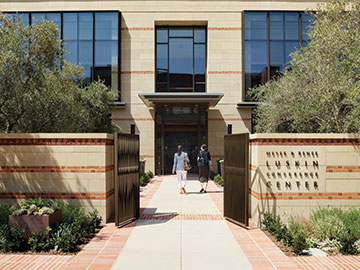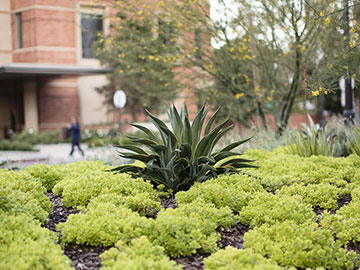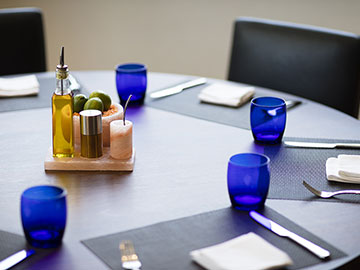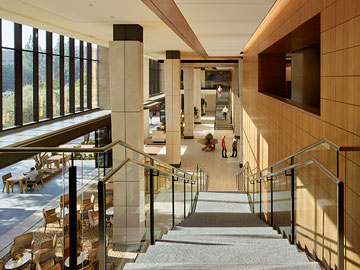
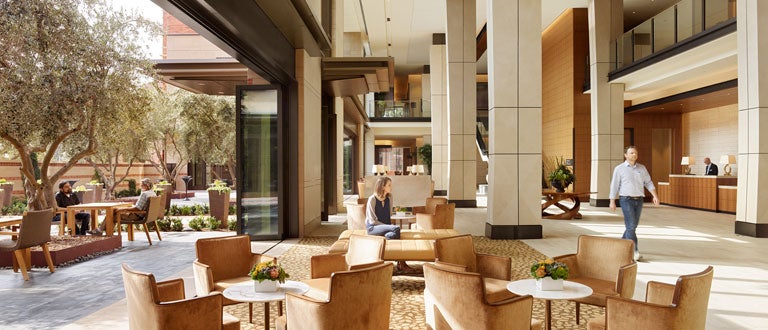
Blue & gold make green
The importance of LEED certification to the UCLA Luskin Conference Center
With a coveted LEED Platinum Certification, every element of the UCLA Meyer and Renee Luskin Conference Center — from the 254 guest rooms to the 25,000 sqft of meeting space to the surrounding landscape — was intentionally designed to leave a minimal impact on the environment and to achieve LEED Certification.
And reach certification it did — LEED Gold, in fact — when it first opened in 2016 due to the latest construction practices, materials and technologies for conserving energy and water, as well as the maximized use of recycled and renewable materials. Importantly, compared to the average commercial building, LEED Gold buildings consume a quarter less energy and generate 34 percent lower greenhouse gas emissions.
This ambitious vision and planning further paid off, when, in the second year of operation in 2017, the Luskin Conference Center garnered a LEED Platinum Certification — the highest distinction — under its belt.
But what is LEED and why is it a big deal? And what does this mean for the meeting planner and guests who stay at the Luskin Conference Center?
LEED, which stands for Leadership in Energy & Environmental Design, is the most widely used green building rating system in the world. Established by the U.S. Green Building Council to promote sustainability-focused practices in the building industry, the LEED certification is a mark of quality and achievement in green building.
The certification aspect of this system means that an independent verification has been done to confirm the building’s sustainable features, allowing for the design, construction, operations and maintenance of resource-efficient, high-performing, healthy, cost-effective buildings. LEED is the “triple bottom line” in action… benefiting people, planet and profit!
This means healthier, more productive spaces, reduced stress on the environment by encouraging energy and resource-efficient buildings, savings from increased building value, higher lease rates and decreased utility costs.
Starting out LEED Gold and now being LEED Platinum assures meeting planners and guests that the Luskin Conference Center meets and exceeds the most stringent environmental, safety and technical requirements. As a global program, LEED maintains consistently high standards that are uniform, from Los Angeles to Mumbai.
Every aspect of the facility, from the most advanced communications technology and resource conservation, to locally sourced food served in its restaurant, Plateia, was planned with sustainability in mind.
Other examples include:
- A concerted effort to reduce water use, such as linen-less banquet set-ups and glass-topped tables for meetings and events. Also:
- In Plateia, elegant table settings mean no linens, but reusable mats on the tables and condiment bowls that are entirely natural, carved of Himalayan salt.
- California wine is offered on tap. Each keg replaces 26 glass bottles and, over the lifespan of a keg, could save literally a ton of glass.
- Lobby and meeting room windows use insulated glass to minimize heat gain while maximizing natural light, therefore reducing energy consumption. It’s been shown that people feel better and listen more in rooms filled with natural light.
- The verdant landscaping around the Conference Center features California-friendly, drought-tolerant plants. A satellite weather controller that governs the minimal, water-efficient landscape irrigation required and plumbing fixtures yield 30 percent savings over baseline code requirements.
- All guest rooms feature high efficiency sinks, showers and toilets.
- Guests are encouraged to contribute to these efforts by participating in the towel reuse program and composting their waste.
- Guest bathrooms feature plant-based shower amenities.
- In fact, the Luskin Conference Center donates all leftover shower amenities to Clean the World, an organization that recycles these items and distributes them to those in need. That unused soap may very well reach a person in need on the other side of the globe.
- All materials used in the interior of the building are low-VOC (Volatile Organic Compounds).
- Ten percent of the building materials are comprised of recycled materials and 10 percent were procured from within 500 miles. Using local materials reduces emission impacts. For example, the brick that dominates the exterior walls of the Luskin Conference Center is locally manufactured.
- Approximately 92 percent of the steel framing is made up of recycled content.
- The elegant wood veneer in the lobby area is Forest Stewardship Council (FSC)-certified from sustainably managed forests.
- The construction team diverted approximately 90 percent of construction waste from landfill through the use of advanced recycling techniques.
- The center transit island has a broken curb to allow water into the swale, where it can soak in and replenish groundwater.
- Additionally, there’s an all-electric vehicle fleet.
Not only does this provide the “feel good” factor of decreasing the carbon footprint and cost savings, the human benefits of greater access to daylight and sunshine cannot be understated. Buildings that optimize wellbeing are more important now than ever.
One of over 30 LEED-Certified buildings on the UCLA campus, the UCLA Luskin Conference Center has set an ambitious goal that it shares with the entire university — to be carbon neutral by 2025. With such a great beginning, we’re optimistic it will reach it!


